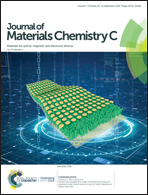A facile synthesis of self-healing hydrogels toward flexible quantum dot-based luminescent solar concentrators and white LEDs†
Abstract
Self-healing hydrogels have become a research hotspot as one of the most promising materials. Particularly, the synthesis of robust hydrogels with flexible transparent properties is highly needed towards soft flexible devices. Herein, we present a new stretchable self-healing poly(AM-co-MAH-β-CD-co-DMAPS) (AM = acrylamide, MAH-β-CD = β-cyclodextrin modified with maleic anhydride, and DMAPS = 3-dimethyl(methacryloyloxyethyl) ammonium propane sulfonate) hydrogel facilely synthesized via frontal polymerization (FP) within several minutes. The as-fabricated hydrogel exhibited pH sensitivity, good transparency and satisfactory mechanical properties with a tensile strength of up to 0.13 MPa and elongation of 600%. Based on its hydrogen bonding interaction and ionic association, excellent self-healing behavior was also achieved with a healing efficiency of up to 95%. More importantly, by introducing the appropriate amount of quantum dots (QDs), we successfully fabricated poly(AM-co-MAH-β-CD-co-DMAPS)/QD hydrogels, which showed great potential towards new flexible luminescent solar concentrators (LSCs) and white LEDs. This study not only offers a rapid synthetic route for self-healing hydrogels via FP, but also sheds great light on their wide applications toward flexible optoelectronic devices.



 Please wait while we load your content...
Please wait while we load your content...